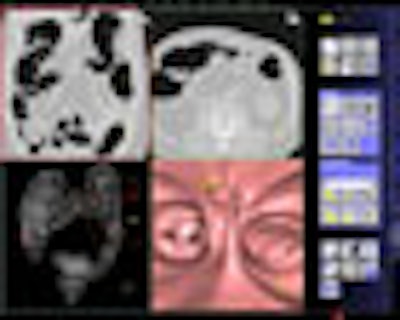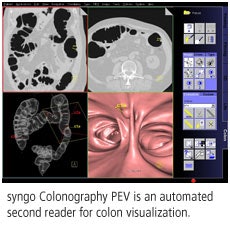
(Booth 7713) Look for Siemens Medical Solutions of Malvern, PA, to use its appearance at the RSNA show to highlight its portfolio of CAD software, which ranges from lung to mammography to colonography applications.
Siemens' syngo Lung CAD software is designed to automatically detect solid lung nodules in thoracic CT studies. New at RSNA 2007 will be CAD results available on PACS workstations via the company's syngo CAD Manager application, a feature available at the end of 2007. The company will also show an improved work-in-progress version of syngo Lung CAD with improved detection for lung nodules.

Features include automated vessel-aligned viewing for optimal visualization and interpretation of potential emboli. The software supports commonly applied CT acquisition protocols for detecting pulmonary embolism, as well as detecting segmental and subsegmental filling defects with high accuracy at a low rate of false-positive marks, according to the company. In addition, CT data can be automatically processed offline using a feature on Siemens' syngo MultiModality Workplace.
syngo PE Detection will be shown as a work-in-progress at the RSNA show, although it is for sale outside the U.S. market.
In virtual colonoscopy, syngo Colonography PEV (polyp enhanced viewing) is a CAD tool that was developed using a database of more than 1,700 colonography cases. The software supports both clean and solid-tagged viewing protocols, and is optimizing for detecting polyps 6-25 mm in size.
New developments on syngo Colonography PEV improve the performance of the software, including superior visualization of flat polyps. The enhanced version of the software will be shown as a work-in-progress, while the previous version is available worldwide and in the U.S.
In the realm of mammography CAD, look for Siemens to highlight its syngo MammoCAD product, which offers CAD analysis of full-field digital mammography studies. Siemens believes the software offers low rates of false positives, with up to 40% of normal cases showing no positive detections at all.
Other features of the software include up to four DICOM input connections and 10 output connections. The software is available internationally, but is not yet available for sale in the U.S. and will be shown as a work-in-progress at the RSNA conference.
For oncology imaging, Siemens will highlight syngo TrueD, an application for PET/CT and SPECT/CT exams, as well as CT or MR fused with PET or SPECT. The software enables physicians to compare patient scans from different time points, such as pre- and post-therapy, while change-detection tools help clinicians make more informed decisions, according to the company.
syngo TrueD supports registration, visualization, quantification, and reporting for up to three time points, and its suite of registration options includes both rigid and nonrigid methods, with built-in matrix navigational tools. It also supports multiple methods for computing standardized uptake values (SUVs), and includes multiple 2D region of interest (ROI) and 3D volume of interest (VOI) tools. syngo TrueD runs on Siemens' syngo MultiModality Workplace 3D workstation, and the software is available in the U.S. and worldwide.
Finally, syngo CXR CAD is a second reader tool for detecting lung nodules in digital chest x-ray studies. Like other Siemens CAD products, it's been integrated with the company's syngo CAD Manager CAD server. The software will be shown at the RSNA show as a work-in-progress, with availability outside the U.S. by the end of 2007.



















